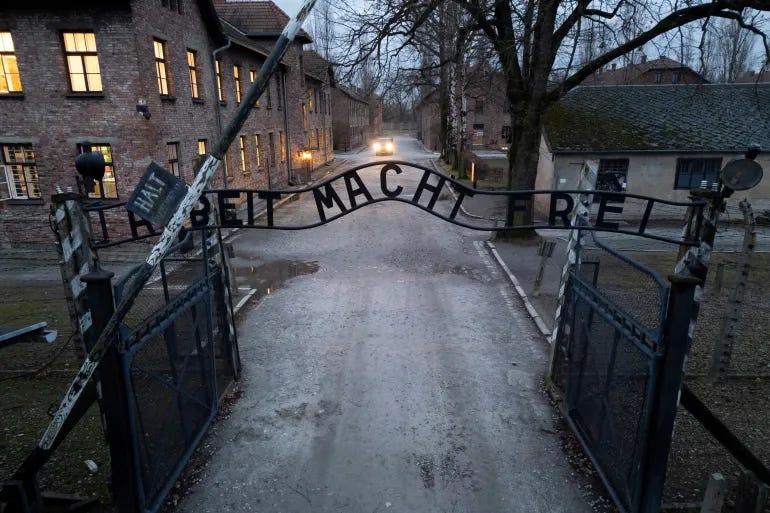Remembering the Lost Souls: The Victims of Auschwitz and Their Untold Stories
Marking 80 years since the liberation of the infamous Nazi extermination camp in Poland, we reflect on the horrors faced by its victims.
"The sky was red, and the air smelled like burned meat. I didn’t understand it then, but my mother told me it was people. People like us." — Ceija Stojka, Auschwitz survivor.
On January 27, 1945, Soviet forces freed the surviving prisoners of Auschwitz-Birkenau, the notorious Nazi concentration and extermination camp in southern Poland. This marked the beginning of the world’s exposure to the unimaginable atrocities committed there, despite earlier reports from British and American intelligence about the widespread killing taking place. Auschwitz stands as one of the largest and most lethal camps in Nazi history, where over a million people, predominantly Jews, were murdered. Among the other victims were Roma, Polish political prisoners, Soviet POWs, disabled individuals, homosexuals, and others targeted by the Nazi regime.
As we observe the 80th anniversary of the camp’s liberation, we reflect on the tragic fates of those who perished there, the different groups that were oppressed, and the voices of those who survived to tell their stories.
The Nazi Network of Camps
The Nazis, fueled by a racist ideology and territorial expansion, established an extensive network of over 44,000 camps across their occupied territories between 1939 and 1945. This network, known as the “Lager”, included concentration camps for persecuted ethnic and political groups, labor camps where prisoners were forced to work under horrific conditions, transit camps, and extermination camps like Auschwitz, which became one of the most infamous killing centers of the Holocaust.
Auschwitz was a complex of multiple types of camps, including forced labor and extermination facilities. It processed tens of thousands of people at a time, most of whom were sent to their deaths. Auschwitz was equipped with gas chambers, crematoria, and a range of other instruments of death. Of the 1.3 million individuals incarcerated at Auschwitz, approximately 1.1 million were killed, making it one of the deadliest sites of the Holocaust.
Auschwitz: The Heart of the Final Solution
After Germany invaded Poland in 1939, the Nazis transformed Auschwitz from an army barracks into a sprawling complex that housed numerous camps, including Auschwitz I, established in 1940 for Polish political prisoners. Later, Jews and other groups were added to the camp. Auschwitz II-Birkenau, constructed between 1941 and 1942, became the largest extermination camp, with gas chambers and crematoria designed to systematically kill and dispose of victims. In total, an estimated 90% of the people who passed through the gates of Auschwitz were Jews, who made up the largest group of victims at the camp.
The Diverse Victims of Auschwitz
Auschwitz's victims came from various backgrounds, each group facing its own particular set of horrors.
Jews: The Primary Target
Jews were the primary target of the Holocaust, and they bore the brunt of Nazi brutality at Auschwitz. Nearly 1.1 million Jews were murdered at the camp, with the majority of them gassed immediately upon arrival. Survivors like Primo Levi, an Italian chemist who later chronicled his experiences, described the brutal conditions, the constant fear, and the never-ending struggle to survive. Jewish prisoners were subjected to forced labor, overcrowded living conditions, inadequate food, and extreme violence.
Roma: The Forgotten Victims
Roma people were also victims of the Nazi regime's genocidal policies. Between 23,000 and 25,000 Roma were sent to Auschwitz, and an estimated 19,000 perished there. They were segregated into a special “Gypsy family camp,” where they faced overcrowding, forced labor, starvation, and brutal medical experiments. Ceija Stojka, a Roma survivor, vividly recalls the constant smell of burning flesh and the death of children in the camp’s gas chambers. The Roma genocide, known as the Porajmos, resulted in the deaths of between 220,000 and 500,000 Roma across Europe.
Polish Resistance and Intellectuals
Polish resistance fighters, intellectuals, and political prisoners also made up a significant portion of Auschwitz’s prisoners. Around 150,000 Poles were held at the camp, with about 75,000 perishing. Members of the Polish resistance, like Wladyslaw Bartoszewski, resisted Nazi control from within, organizing secret networks, providing aid to fellow prisoners, and documenting the Nazis’ atrocities.
Conscientious Objectors: Standing Firm in the Face of Brutality
Jehovah’s Witnesses, who refused to swear allegiance to Hitler, were imprisoned in Auschwitz. Though they were subjected to forced labor and abuse, they maintained their spiritual strength, offering mutual support to fellow prisoners. Their commitment to nonviolence made them stand out as a unique group among those detained by the Nazis.
Prisoners of War and Other Minorities
Soviet prisoners of war, viewed as "subhuman" by the Nazis, were also sent to Auschwitz. They faced the harshest conditions, suffering from extreme starvation, disease, and forced labor. Many of them perished from these inhumane conditions.
Other minorities, including homosexuals and disabled individuals, were targeted for persecution under Nazi eugenics programs. Disabled people were often subjected to medical experiments or murdered in gas chambers.
The Liberation and Its Aftermath
By January 1945, as the Soviet army closed in on Auschwitz, the Nazis began evacuating the camp, forcing tens of thousands of prisoners on death marches to other camps. Many perished along the way from exhaustion, exposure, or execution. When Soviet forces entered the camp on January 27, 1945, they found around 7,000 survivors, many of whom were in severe condition. They also discovered the horrifying evidence of mass murder: piles of corpses, gas chambers, and crematoria.
The liberation of Auschwitz exposed the scale of Nazi crimes and remains a powerful symbol of the horrors of the Holocaust. As we remember the victims and survivors, we are reminded of the importance of education, remembrance, and the ongoing fight against hatred and bigotry.


